
|
|
|
|
|
|
Classic Bikes
Custom Bikes
Individual
Racing Bikes AJP
AJS
Aprilia
Ariel
Avinton / Wakan
Bajaj
Benelli
Beta
Bimota
BMW
Brough Superior
BRP Cam-Am
BSA
Buell / EBR
Bultaco
Cagiva
Campagna
CCM
CF Moto
Combat Motors
Derbi
Deus
Ducati
Excelsior
GASGAS
Ghezzi Brian
Gilera
GIMA
Harley Davidson
Hero
Highland
Honda
Horex
Husaberg
Husqvarna
Hyosung
Indian
Jawa
Kawasaki
KTM
KYMCO
Laverda
Lazareth
Magni
Maico
Mash
Matchless
Mondial
Moto Guzzi
Moto Morini
MV Agusta
MZ / MuZ
NCR
Norton
NSU
Paton
Peugeot
Piaggio
Revival Cycles
Roland Sands
Royal Enfield
Sachs
Sherco
Sunbeam
Suzuki
SWM
SYM
Triumph
TVS
Ural
Velocette
Vespa
Victory
Vincent
VOR
Voxan
Vyrus
Walt Siegl
Walz
Wrenchmonkees
Wunderlich
XTR / Radical
Yamaha
Zero
Video
Technical
Complete Manufacturer List
|
Honda CBR1000RR-R Fireblade |
| . |
|
Make Model |
Honda CBR1000RR-R Fireblade |
|
Year |
2021 |
|
Engine |
Four stroke, transverse 4 cylinder, DOHC, 4 valves per cylinder |
|
Capacity |
999.9 cc / 61 cu-in |
|
Bore x Stroke |
81 x 48.5 mm |
|
Compression Ratio |
13.0:1 |
|
Cooling System |
Liquid cooled |
|
Exhaust |
Titanium Akrapovič |
|
Induction |
Programmed Dual Stage Fuel Injection (PGM-DSFI) with 52mm throttle bodies, Denso 12-hole injectors |
|
Ignition |
Digital transistorized with electronic advance |
|
Battery |
12-6 YTZ7S |
|
Starting |
Electric |
|
Max Power |
215 hp / 160kW @ 14500 |
|
Max Torque |
113 Nm / 83 lb-ft @ 12500 |
|
Clutch |
Wet, multiplate hydraulic clutch with assist slipper |
|
Transmission |
6 speed |
|
Final Drive |
#525 Chain, 16T/43T |
|
Frame |
Twin-spar aluminum |
|
Front Suspension |
43mm Showa telescopic inverted fork, and a big piston front fork with preload, compression and rebound adjustment |
|
Front Wheel Travel |
120 mm / 4.7 in |
|
Rear Suspension |
Unit Pro-Link with gas-charged HMAS damper featuring 10-step preload and stepless compression and rebound damping adjustment. Showa Balance-Free Rear Cushion with preload, compression and rebound adjustment |
|
Rear Wheel Travel |
137 mm / 5.4 in |
|
Front Brakes |
2x 330mm discs w/ radially mounted 4-piston Nissin calipers |
|
Rear Brakes |
Single 220mm disc w/ 2-piston Brembo caliper |
|
ABS System |
Standard 2 channel |
|
Wheels |
Cast aluminum |
|
Front Wheel |
3.5 x 17 |
|
Rear Wheel |
6.0 x 17 |
|
Front Tyre |
120/70ZR17 |
|
Rear Tyre |
200/55ZR17 |
|
Rake |
24° |
|
Trail |
101.6 mm / 4 in |
|
Dimensions |
Length 2100 mm / 82.7 in |
|
Wheelbase |
1455 mm / 57.3 in |
|
Seat Height |
828 mm / 32.6 in |
|
Ground Clearance |
115 mm / 4.5 in |
|
Wet Weight |
201 kg / 443 lbs |
|
Fuel Capacity |
16 Litres / 4.3 US gal |
| . |
The CBR1000RR-R is a brand-new motorcycle, built with an unwavering focus on circuit riding, with unprecedented levels of performance and control. Its inline four-cylinder engine draws heavily on the RC213V-S’s combustion efficiency and low-friction technologies – while also sharing its bore and stroke; it also features titanium con-rods and forged aluminium pistons. Honda Selectable Torque Control (HSTC) has been optimised and adjustable Start Mode added to Power, Engine Brake and Wheelie Control. An aluminium diamond frame features a longer RC213V-S-style swingarm, with six-axis Inertial Measurement Unit (IMU), 3-level Honda Electronic Steering Damper (HESD) and Showa suspension front and rear. New Nissin brake calipers bite 330mm discs through 2-level ABS. The bodywork and riding position have an uncompromising focus on aerodynamic performance, and the fairing features MotoGP-derived winglets to generate downforce. A full-colour TFT screen and Honda Smart Key are the finishing touches.
Introduction
Since its original 1992 introduction Honda’s iconic Fireblade has evolved into an incredible 1000cc sports motorcycle. And it’s also been the base of a competitive race machine, on short circuits around the world and the roads of the Isle of Man TT.
But time – and competition – marches on, Honda is drawing a line under where the has been, and looking forward to where it’s going. Two brand-new motorcycles – the CBR1000RR-R Fireblade and CBR1000RR-R SP Fireblade – have been created, with heavy involvement from Honda Racing Corporation, to carry the legend forward.
Leaning heavily on the engine and chassis technology of the RC213V-S ‘street-legal MotoGP machine’, with aerodynamics drawn from the RC213V MotoGP bike, the new Fireblade has been designed from the ground up scratch – in terms of engine, handling and aerodynamics – for outright track performance.
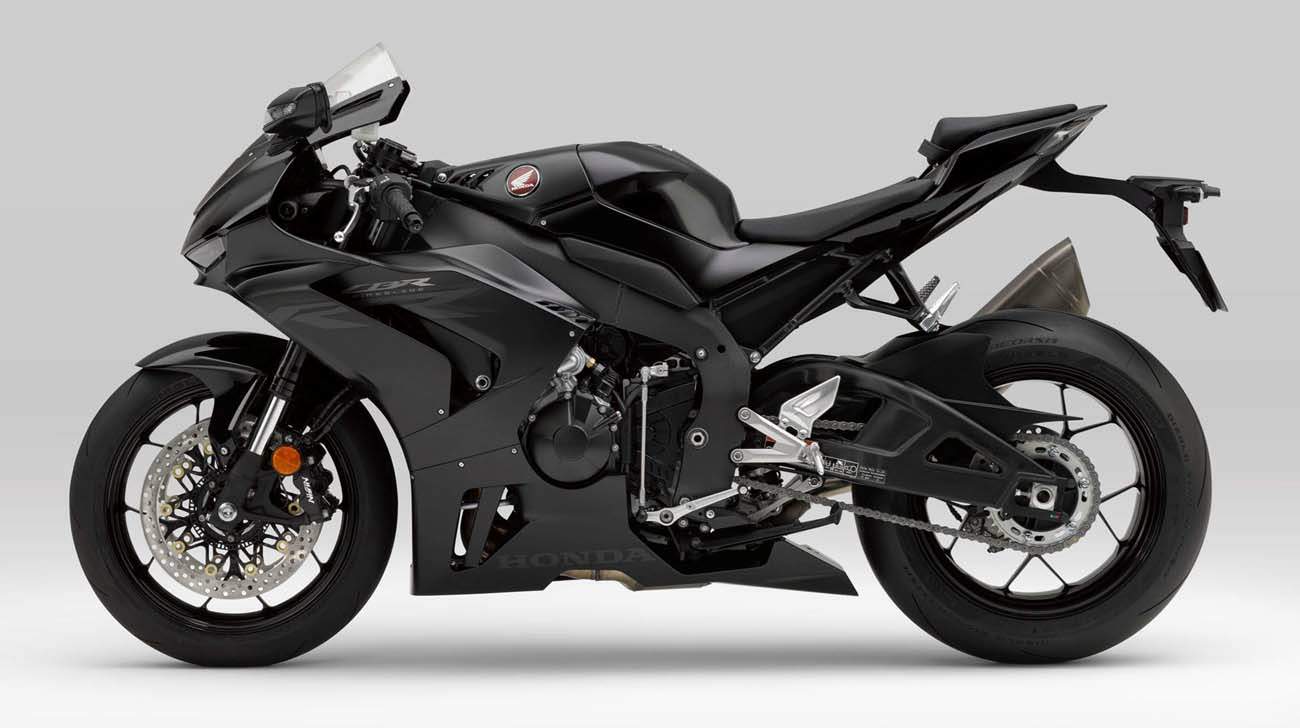
Mr Yuzuru Ishikawa, Large Project Leader (LPL) 20YM CBR1000RR-R Fireblade said:
“This year a brand-new Fireblade is born. And our intentions are crystal clear. The CBR1000RR-R’s battleground has moved to the race track, where its advanced performance can be most fully demonstrated. The engine has the same bore and stroke as the RC213V, and we have chosen to maintain an inline four-cylinder engine configuration and regular combustion interval for the freedom in packaging, high power and ease of control this layout affords. We firmly believe riders everywhere can experience a whole new level of performance with our new CBR1000RR-R – a machine in its element on the track.”
Model Overview
From a clean sheet, Honda and HRC’s development engineers set to work creating a new inline four-cylinder engine for the CBR1000RR-R Fireblade. It’s a compact, short-stroke layout – sharing the bore and stroke of the RC213V – and features a semi-cam gear train, finger-follower rocker arms, titanium con-rods, RC213V-S internal friction reduction technologies, piston jets with check ball system and a built-in bottom bypass passage for the cylinder water jacket.
A ram-air duct in the front fairing feeds through the headstock directly into the airbox. The 4-2-1 exhaust downpipes are ovalized and the end-can has been developed in conjunction with Akrapovic.
The result? The CBR1000RR-R engine delivers 113Nm @ 12,500rpm and makes peak power of 160Kw @ 14,500rpm.
Throttle By Wire has been enhanced for improved feel and three default riding modes feature options to change Power, Engine Brake, Wheelie Control and the optimised Honda Selectable Torque Control (HSTC). The electronics package also now includes adjustable Start Mode.
A totally new aluminium diamond frame uses the rear of the engine as the upper shock mount; the swingarm is longer and based on the RC213V-S design. The rigidity balance, weight distribution and steering geometry have been carefully adjusted for the increased engine output, in terms of front and rear grip levels, and feel for both.
Showa’s 43mm Big Piston Fork (BPF) is matched to a Showa Balance Free Rear Cushion Light (BFRC-L). The front discs are larger in diameter and worked by new Nissin four-piston calipers while the ABS is adjustable for track riding. The rear tyre is now sized 200/55-ZR17.
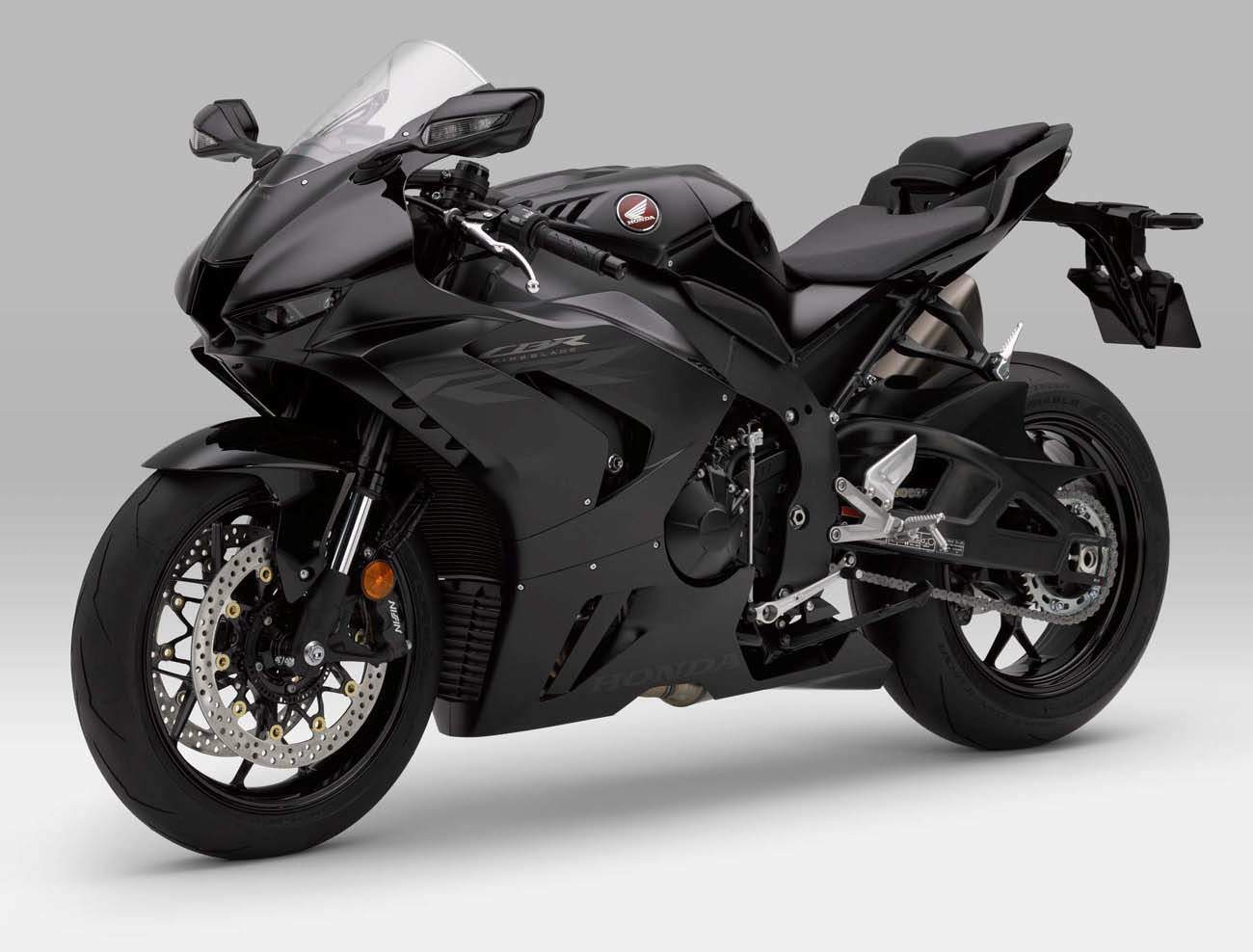
A six-axis Inertial Measurement Unit (IMU) provides accurate 3D estimation of riding dynamics and provides input to manage all of the electronic systems. It also controls the new rod-type 3-level Honda Electronic Steering Damper (HESD).
Honda’s RC213V MotoGP machine has leant some of its slippery aerodynamics to the CBR1000RR-R, including winglets to increase downforce and improve braking stability. The riding position is also much more compact.
The fully customisable 5-inch TFT display offers intuitive control operated via a simplified four-way switch on the left handlebar. Honda’s Smart Key system adds convenience.
Key Features
Engine
- Short-stroke, inline four-cylinder engine produces high output at high rpm
- Ultra-compact design due to semi-cam gear train and starter motor driving
through clutch main shaft
- Internal friction reduced by Diamond Like Carbon (DLC) cam lobes and
bottom-bypass water jacket
- Finger-follower rocker arms, titanium con-rods and forged aluminium pistons
reduce inertial weight
- Airbox fed by ram-air duct tunnel through the steering stem
- Titanium end-can developed in conjunction with Akrapovic
The CBR1000RR-R Fireblade’s 1000cc inline four-cylinder engine is completely new and designed with heavy input from the HRC MotoGP development program. It now generates peak power of 160Kw @ 14,500rpm, with peak torque of 113Nm @ 12,500rpm.
To achieve the required valve size, combustion efficiency and friction reduction to generate these numbers, the RR-R engine shares the same ‘over square’ 81mm bore and 48.5mm stroke as the RC213V– a radical change from the 76 x 55.1mm of the previous design, and the largest bore size among inline four-cylinder 1000cc machines.
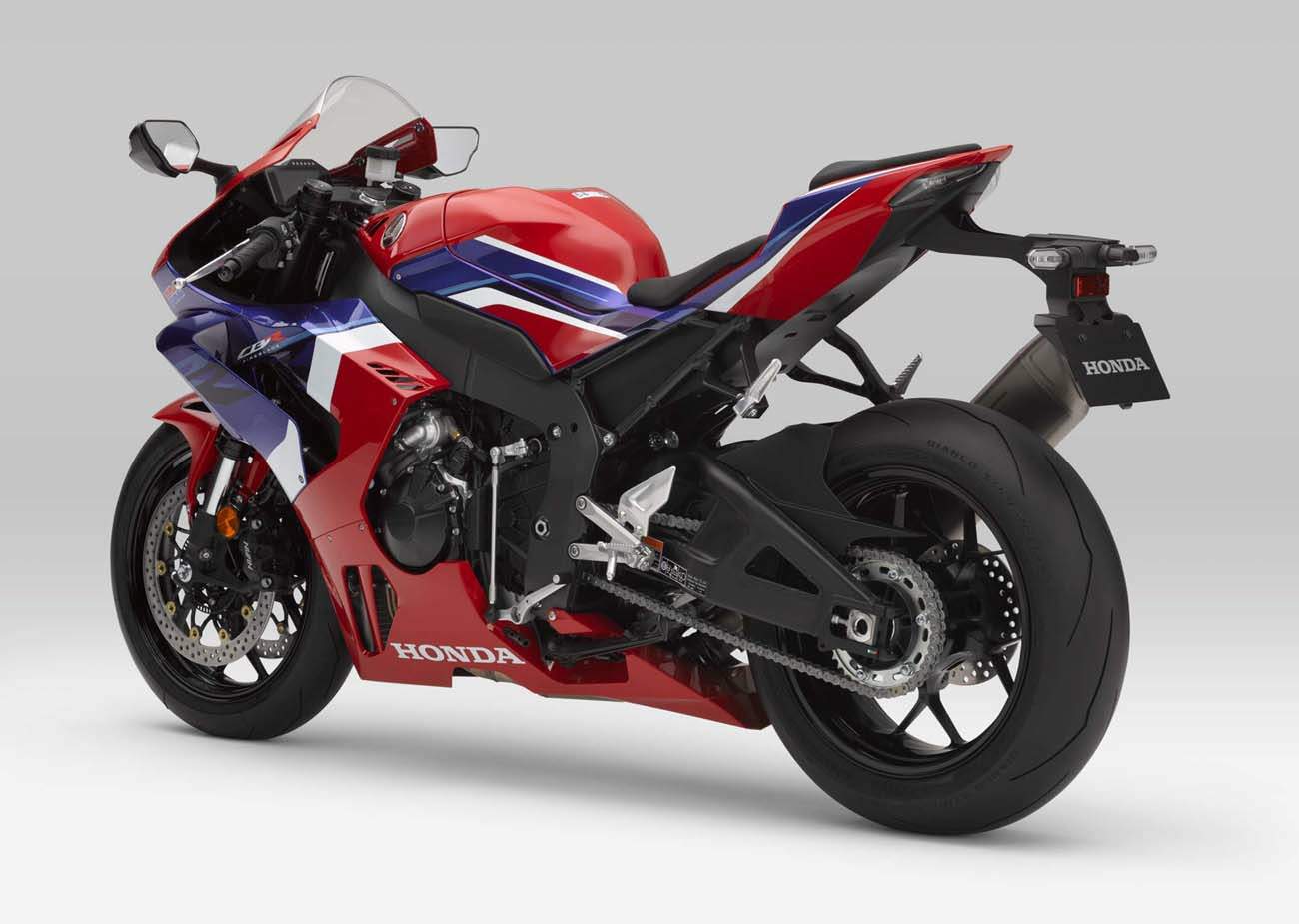
Compression ratio is set at 13.0:1. The inlet valves are 32.5mm diameter, with 28.5mm exhaust; they’re also now operated by finger-follower rocker arms (as opposed to bucket valve drive) which reduces inertial weight by approximately 75%. Friction is further reduced by the use of Diamond Like Carbon (DLC) on the cam lobes – just like the RC213V-S. This is the first time this process has been used on a mass-produced motorcycle and sees a reduction in valve train frictional loss of 35% compared to non DLC-coated lobes. To reduce crankshaft deflection (due to inertia and combustion energy) the crank journals are larger and the crankcase wall thickness has been optimised.
The valve train is driven by a new (patent pending) semi-cam gear train system. To drive such high-rpm/high-cam lift performance the chain is driven from the timing gear located on the crank shaft via the cam idle gear – this makes it shorter in length.
Forged, lightweight TI-64A Titanium (a material developed by Honda) con-rods and con-rod caps save 50% in weight compared to Chromium Molybdenum steel versions; they also employ HB 149 Chromium Molybdenum Vanadium (Cr-Mo-V, again a Honda development) steel bolts and do without fastening nuts.
To ensure durability the same configuration as the RC213V-S is applied to the sliding surfaces – the small-end bushings are made of shaved C1720-HT Beryllium copper (because of its high-rpm reliability) while the surfaces of the big-ends are treated with DLC.
The pistons are forged from A2618 aluminium (the same as the RC213V-S) for lightweight strength and durability and each piston is 5% lighter than before. To guarantee high-rpm wear resistance the piston skirts now feature an Ober coating (Teflon and Molybdenum base) and nickel-phosphorous plating for the piston-pin clip-groove.
To manage temperature increase the pistons use a multi-point piston jet which sprays cooling oil in multiple directions through each cycle. At low rpm – when not needed – check balls within the jets shut off the flow of oil in order to limit oil pressure loss and reduce friction.
Air is fed into the engine via a ram-air duct located at the high-surface pressure tip of the front fairing; the size of its aperture is equivalent to that of the RC213V MotoGP machine. A ribbed ‘turbulator’ to the right, left and above the duct entrance ensures maximum induction of moving air with minimal impact on handling. The draft angle of the aperture’s interior wall maintains flow under high-speed and acceleration.

To maintain stable performance across a wide speed range, pressurised air takes a straight shot through the headstock, around the steering stem and into the airbox. This smooth path is made possible by the application of Honda’s Smart Key system (dispensing with a traditionally-mounted ignition barrel) and steering angle of 25°.
The ‘dirty’ side of the air filter has been enlarged to lower airflow speed and it’s also 25% bigger than the previous design and angled for an even flow. On the ‘clean’ side, filtered air changes direction into the largest volume of the airbox and – along with fuel from the upper injector – feeds to an eccentric bell-mouth funnel. The result is reduced drop in intake air pressure – and more efficient breathing for more performance.
To draw the volume of air needed the throttle body diameters have been enlarged from 48 to 52mm. An oval internal cross-section makes for smooth flow – and further reduces intake pressure drop – from the throttle butterfly valves to the inlet valves.
The valve angle on the intake side has been reduced from 11° to 9°. This change improves combustion efficiency by reducing the surface area of the combustion chamber, and gas flow efficiency of the intake ports is increased by approximately 2%.
The port volume (the capacity between throttle butterfly valves and intake valve seat) has been reduced 13% to improve throttle response. And the throttle shaft is now constructed from highly rigid stainless steel (as opposed to brass) reducing deflection and operational friction, putting a much more direct connection into the rider’s right hand.
Mirroring the intake side, the four exhaust downpipes have optimised diameters and an oval cross section to improve gas flow. The catalyser unit is 10mm larger in diameter to reduce exhaust pressure drop, and careful adjustment of wall thickness has minimised any weight increase.
Akrapovic partnered in development of the exhaust end-can. Constructed from titanium, its small physical size and light weight contribute to mass centralisation and right-side lean angle. The exhaust valve was also designed with Akrapovic to deliver both low-rpm torque and high-rpm power; a valve stopper (patent-pending) stops exhaust-gas leak when closed while also reducing noise, allowing total end-can internal volume to reduce by 38% compared to the outgoing design.
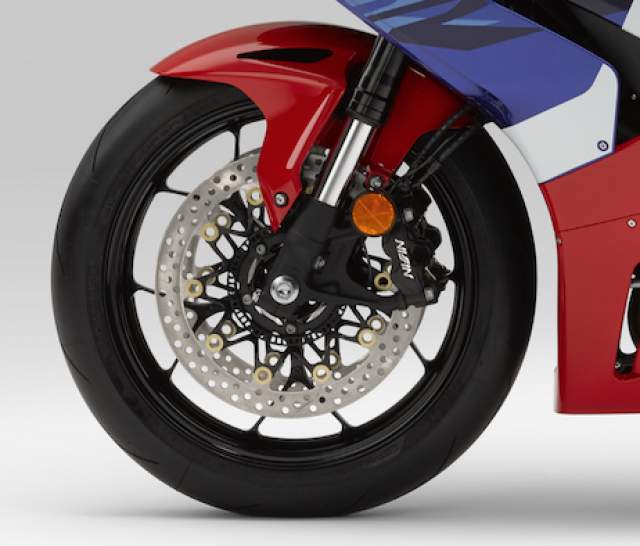
Minimising friction elsewhere in the RR-R engine was a key focus in obtaining the increase in rev-range. To reduce bore distortion (and thus friction), the cylinder features a patent-pending built-in bottom bypass. This system circulates cool water from the radiator into the main water jacket, while the area below uses non-cooled water. The net effect is a lower, and more even temperature at all points across the bores compared to the previous engine. An external hose is also eliminated.
To reduce width the engine is started by rotation of the clutch main shaft rather than the crankshaft. Patent-pending, this design allows for a more compact crankshaft while double use of the primary driven gear (which itself is smaller, with fewer teeth) to also transmit rotation from the starter motor saves space; the engine is shorter in length thanks to reduction in distance between the crankshaft, counter shaft and main shafts. The rear of the engine block also now serves as the upper shock mount.
Engine/Electronics
- Throttle By Wire optimised for faster response and improved feel
- Three default riding modes plus options to customise Power, Engine Brake and
Wheelie control
- Honda Selectable Torque Control (HSTC) gains slip rate control for smooth
torque management over 9 levels
- Start Mode standard fitment
The 17YM CBR1000RR was the first in-line four-cylinder engine from Honda to use Throttle by Wire (TBW). Derived and developed from the system used by the RC213V-S, it controls the throttle butterfly valve angle (relative to input from the throttle) to provide a linear delivery and puts precise throttle control – and a natural feel – in the rider’s right hand.
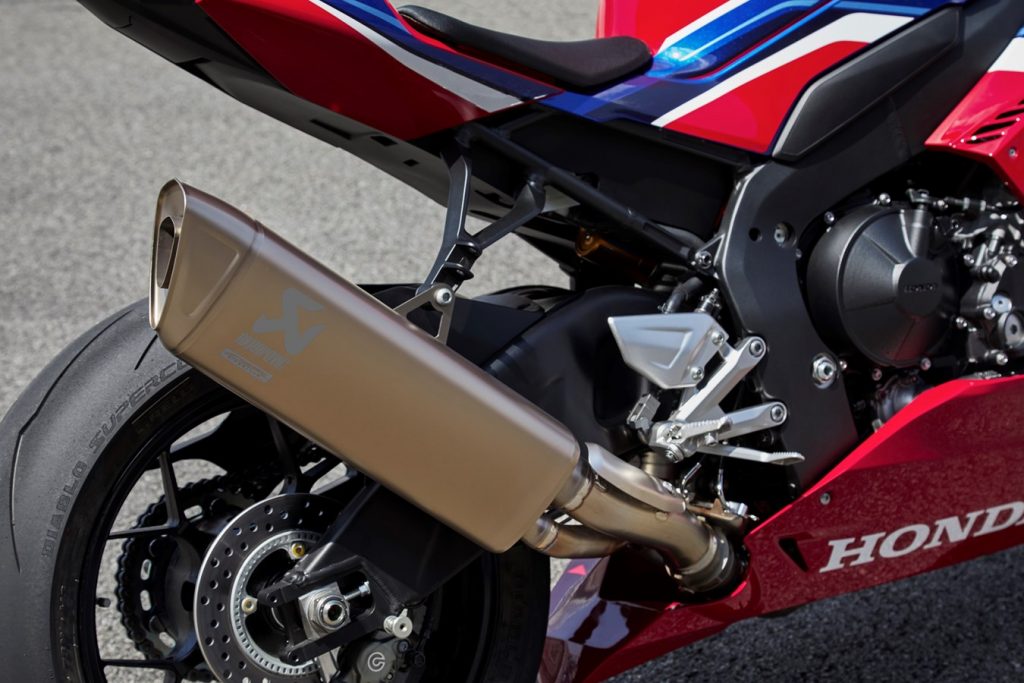
For the CBR1000RR-R, TBW has been improved for faster response through a range of part throttle applications – such as gradual opening on corner exit – to minimise any delay in torque delivery.
There are three default riding modes, with options to change engine output and character (see diagram). Power (P) operates through levels 1-5 with 1 giving ultimate outright power. Engine Brake (EB) manages performance on a closed throttle through levels 1-3, with 1 being the strongest engine braking and Wheelie (W) through levels 1-3 (plus off) with 1 giving the weakest intervention.
Wheelie control uses information gathered by the IMU on the RR-R’s pitch angle, along with front and rear wheel speed sensors to maintain torque and deal with the wheelie without sacrificing forward drive.
Honda Selectable Torque Control (HSTC) adjusts through 9 levels (plus off) with 1 giving weakest intervention. It has been optimised for the RR-R and now adds slip rate control (when the slip change rate based on ratio of front/rear wheel speeds exceeds predetermined values) to moderate rapid wheel spin (see diagram). In conjunction with the existing outright slip control, HSTC is smooth in operation while delivering maximum confidence for the rider.
The CBR1000RR-R is also equipped with Start Mode for race starts. It limits engine rpm at 6,000, 7,000, 8,000 and 9,000rpm set-points, even with a wide-open throttle, letting the rider focus on clutch release (and lights) alone.
Chassis
- New aluminium frame and swingarm change weight distribution, centre of
gravity and rigidity balance for improved handling and traction
- Bosch six-axis Inertial Measurement Unit (IMU) for accurate calculation of
machine dynamic behaviour and precise control
- Showa 43mm Big Piston Fork (BPF) and Balance Free Rear Cushion Light (BFRC-Light)
rear shock offer complete adjustability
- Showa’s new 3-level Honda Electronic Steering Damper (HESD) controlled by IMU
for precise stability management
- New dual Nissin radial-mount four-piston calipers managed by ABS with
switchable SPORT/TRACK modes

The reduction in physical size of the CBR1000RR-R’s engine opened up new packaging options around it for the new frame and swingarm – with completely revised geometry. The goals? Even more accurate high-speed steering, improved stability under acceleration and braking, and feel for front and rear grip on the limit. And at the very highest level of competition.
The diamond frame is constructed from 2mm aluminium and allows much more accurate tuning of the rigidity balance; in manufacture, after the four main frame components are welded, the engine now mounts in six locations improving machine handling. Vertical and torsional rigidity are increased by 18% and 9%, with horizontal rigidity decreased by 11% – all aimed at producing maximum levels of feel.
Wheelbase is now 1,455mm, with rake and trail of 24°/102mm (from 1405mm, 23°/96mm) for stability. Wet weight is 201kg. There have also been considerable changes to balance and centre of gravity; the crankshaft is 33mm further from the front wheel spindle and raised 16mm. This evens out weight distribution, while the higher c-of-g improves side-to-side agility.
The swingarm – stamped out from 18 individual thicknesses of aluminium and as used by the RC213V-S – is 30.5mm longer, at 622.7mm, but weighs exactly the same as the previous design. Its horizontal rigidity is reduced by 15%, with vertical rigidity maintained to generate grip and feel.
For optimum frame rigidity (and to save weight) the top mount of the Pro-Link rear suspension attaches to the rear of the engine block via a bracket, doing away with the upper cross-member. This also isolates the rear wheel from the headstock, improving high-speed stability and feel for rear wheel traction.
Round, thin-wall aluminium tubing forms the minimal subframe. It also mounts to the frame from the top (rather than sides) to narrow the area around the rear of the fuel tank and seat, making for a compact – and aerodynamically efficient – riding position. Seat height is 830mm, with the handlebar position pushed forward (for leverage) and foot pegs moved rearward, and up.
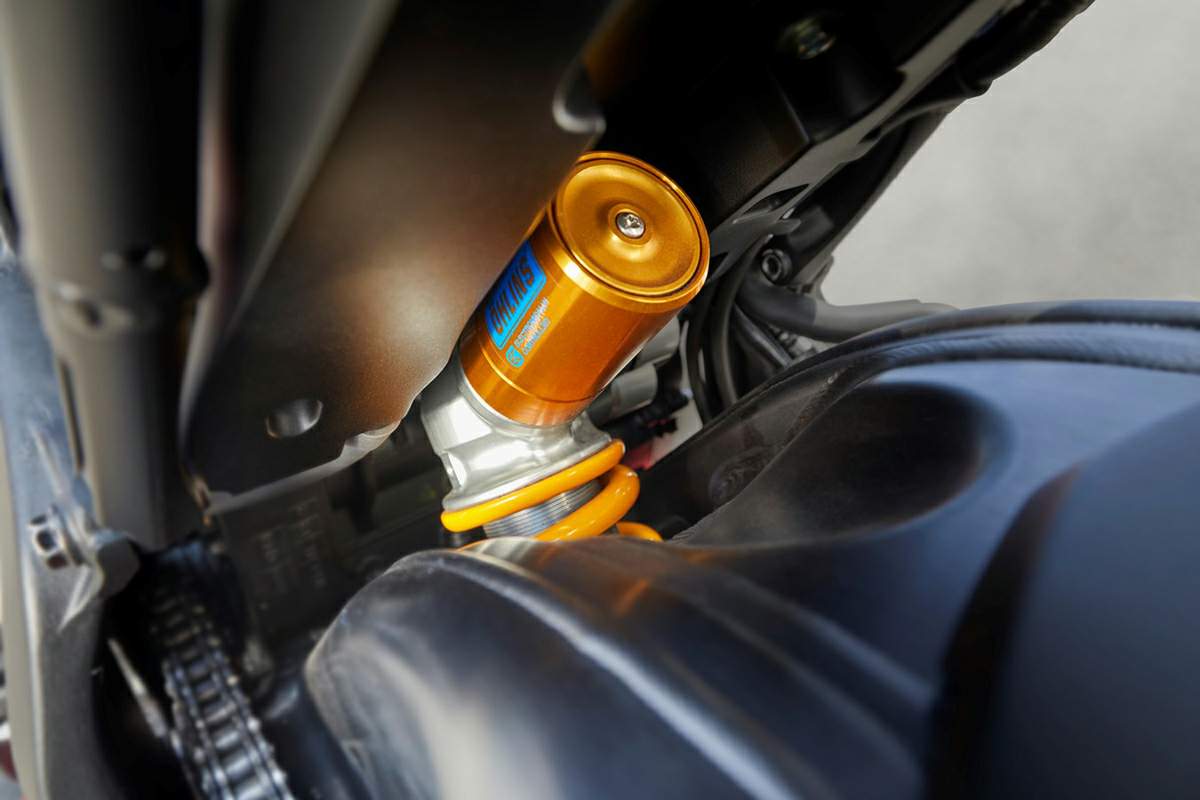
A Bosch six-axis Inertial Measurement Unit (IMU) replaces the five-axis unit of the previous design; this allows more accurate calculation of pitch and roll for even more precise control of bike behaviour.
The CBR1000RR-R is also equipped with Showa’s new Honda Electronic Steering Damper (HESD). A lightweight through-rod design that mounts on the bottom of the steering stem and attaches to the bottom yoke, HESD is controlled by input from the wheel speed sensors and IMU; 3 levels of control are available.
With its large damping volume, the Showa 43mm Big Piston Fork (BPF) inverted telescopic fork effectively reduces hydraulic pressure generated under compression and extension. This results in reduced play during the initial stroke and smoother damping, maximising tyre contact with the tarmac. Spring preload and rebound/compression damping are fully adjustable and for the RR-R the fork is longer in length than before, allowing more freedom for geometry changes track-side.
The rear shock is a fully adjustable Showa Balance Free Rear Cushion Light (BFRC-Light). Instead of a conventional single-tube layout, BFRC-Light uses a double-tube design: the damper case and an internal cylinder. The damper piston has no valves – instead the damping force is generated as displaced oil passes through a separate damping component.
This allows pressure changes within the shock to be smoothly controlled, damping response and reaction to be improved, and damping force to function smoothly during load input. Moreover, damping weight is generated consistently when switching from rebound to compression due to even pressure changes.
New Nissin four-piston radial mount front brake calipers are fitted, which offer more rigidity with reduced weight, and grip 10mm larger 330mm diameter discs. Braking power is improved for track use; the 5mm disc thickness also dissipates heat more efficiently. The rear brake caliper is the same Brembo unit used by the RC213V-S.
Rear lift control and ABS-managed brake force relative to lean angle were a feature of the previous design. For the CBR1000RR-R the system gains two switchable modes; SPORT mode focuses on road-riding performance, with high brake force and less pitching, while TRACK mode offers performance in braking from much higher circuit speeds.
The rear 17-inch rim has new hub geometry, to save weight while maintaining rigidity and mounts a 200/55-ZR17 sized tyre (from 190/50-ZR17) minimising the change in chassis geometry when going from street to track rubber. The front rim mounts a 120/70-ZR17 tyre.
Aerodynamic Package & Equipment
- Aerodynamic fairing, screen and mudguard minimise frontal area and reduce
drag; lower fuel tank also provides more compact riding position
- Inner fairing winglets drawn from the RC213V MotoGP machine reduce wheelies
under acceleration and improve braking stability
- 5-inch colour TFT screen and simplified four-way left-hand switch offer
intuitive control of riding systems
- Honda Smart Key adds convenience and simplifies top-yoke design
Alongside its new engine and chassis the CBR1000RR-R has an aggressive new fairing design. It’s no mere styling exercise however; the drivers in development were to create a class-leading drag coefficient (with a tucked-in rider under track conditions) and restrict lift under acceleration while improving braking stability.
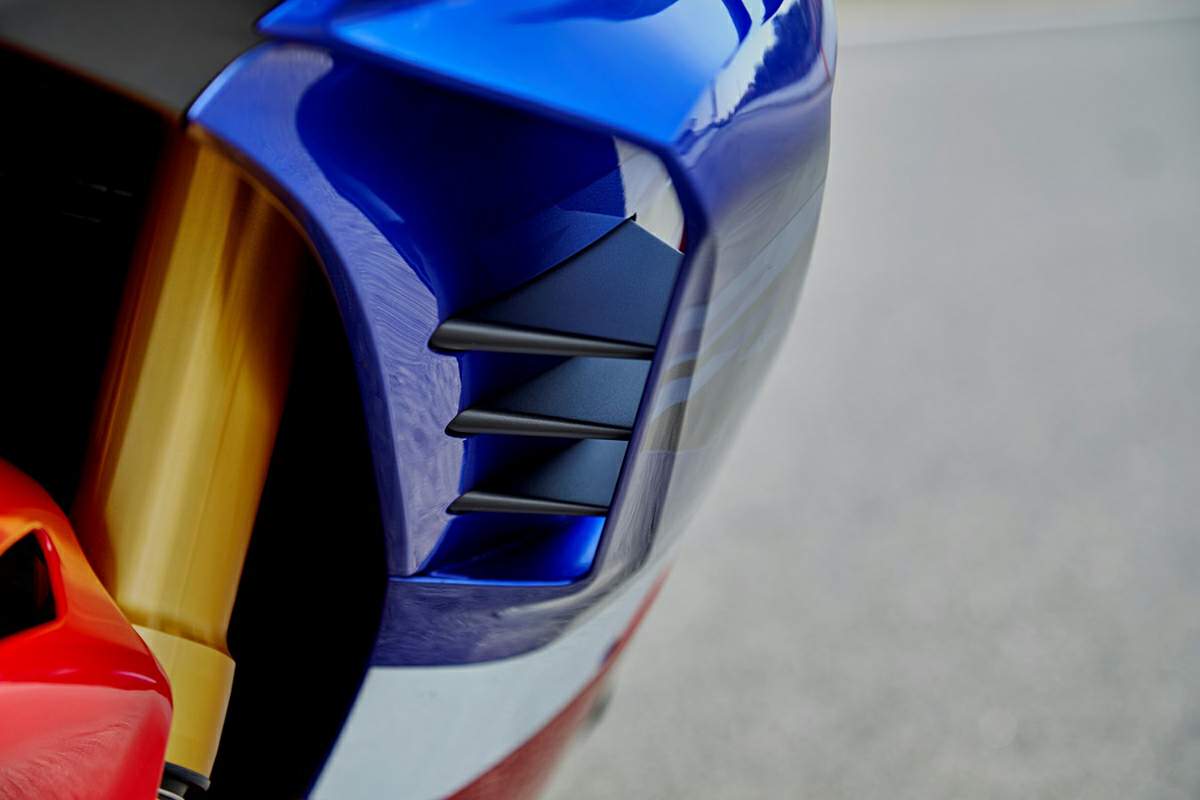
The first part of the process was to lower the fuel tank cover by 45mm (compared to the previous design) decreasing the frontal area with the rider prone. At a 35° angle the screen smoothly channels airflow from the upper fairing over the rider and seat cowl, which itself presents the minimum possible drag resistance. The left and right upper fairing slits reduce yaw and roll resistance while turning.
To make steering easier a convex surface on each side of the front mudguard moves air flow away from the front wheel, smoothly directing it to the fairing sides. Cooling air for radiator and oil cooler has been optimised by aerodynamic management of both velocity and pressure of air flowing from the tyre.
The lower fairing has been extended close to the rear tyre, and shaped to channel air downward. This has two effects: in dry conditions, less air hits the tyre, lowering drag; in the wet, less water hits the tyre, improving grip. To let air flow around the rider’s feet with minimum resistance the sides of the rear hugger are carefully shaped while its upper side is cut-out to vent air that channels up from underneath either side of the swingarm, decreasing rear lift.
The net result of all this work, with the CBR1000RR-R in stock race trim, is a best-in-class drag coefficient value of 0.270.
To generate downforce at track speeds – and maintain the smallest possible frontal area – the CBR1000RR-R employs winglet structures that effectively generate the same downforce as the 2018 RC213V MotoGP machine. The results are a reduction in wheelies under acceleration and increased stability on braking and corner entry.
Three wings are arranged in a vertical line inside both left and right fairing ducts. This arrangement (vertically deep and longitudinally shallow) has no detrimental effect on yaw and roll ability during corner entry. And the consistent distance between the trailing wing tips and the inner fairing wall limits separation of the airflow, producing maximum downforce.
The wing angle balances opposing right/left downforces from the dihedral and twist angles when yaw occurs through a corner, for stable behaviour. Flow speeds over the top and below the wings differ to prevent air getting ‘trapped’ on the fairing sides and affecting handling.
For full and intuitive control of the CBR1000RR-R’s systems the full colour 5-inch TFT screen is larger and with higher resolution. It’s fully customisable to show exactly what the rider wants to see. The compact left hand switchgear houses a four-way switch. Fast and easy to use, the top/bottom buttons set riding mode parameters, while the left/right buttons cycle screen display information.
Honda’s Smart Key System has been added. The ignition now operates without having to insert a key, as does handlebar lock. This is both convenient in day-to-day use and has allowed use of a competition-style top yoke while freeing up optimum space for the ram air system.
|
Any corrections or more information on these motorcycles will be kindly appreciated. |